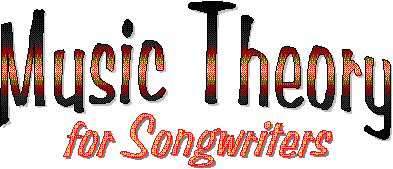



Concept #5 - ii, iii, and vi
The ii, iii, and vi chords are minor chords built on notes 2, 3, and 6 of the scale. They have a different sound than the three major chords we have already discussed. This adds many new possibilities to your music.
First, let's fill in the rest of the table.
Now answer this question. In the key of D, name the three major chords and the three minor chords.
The answer: the three major chords (I, IV, and V) are D, G, and A, while the three minor chords (ii, iii, and vi) are E minor, F# minor, and B minor.
What do the new chords look like?
The Em chord looks like this.
This is the F# minor chord.

And B minor looks like this.

On a guitar, Em, F#m and Bm look like this.
Concept #6 - The Simple Map
This is where the big question begins to emerge. We now have six chords available. How do they flow from one to another?
There are two answers. The simple answer is... it doesn't matter which chord comes next as long as it sounds good. In some ways, this answer is correct. All six chords come from the same scale, and they work well enough together to just bounce from one to the other. But there is a better answer, though it takes longer to understand.
The better answer goes like this. Chords are flowing through the song, but they are also flowing into the minds of your listeners. To the listener, chords have an effect. Some chords feel stable and strong while others feel like they're leaning or going somewhere. Some chords create tension, waiting for another chord to come along and relax the tension. Sometimes a chord is meant to surprise the listener; sometimes to soothe. And there is also a kind of guessing game going on. The audience is wondering what chord comes next. Sometimes they guess right. Sometimes you throw them a curve.
In general, you want to throw enough curves to keep your audience guessing, but not so many that they start striking out. The listeners feel better when they "hear" chords coming, and guess right... just not all the time. They want to be surprised some of the time.
What I'm about to show you is a map. The map has one very simple purpose. It shows you chord sequences that your audience will tend to "guess in advance." These chord sequences sound natural, like walking down the stairs, with no sudden jumps or unexpected turns. A lot of music is created with simple sequences like these.
Concept #7 - Using The Simple Map
To use the map, remember two things. First, you may jump anywhere from I. Second, if a chord appears at more than one place, there is an "imaginary tunnel" connecting both spots, so you can move from one to the other. Got it?
With the map you can do exercises like:
1. Write a long "loop," starting with the I chord, Jump from I to wherever you like. Then work your way back to I by following the arrows.
2. Write several three or four chord sequences. Start anywhere on the map. Follow the arrows.
Here are some possible answers.
I - iii - vi - IV - ii - V - I is a "loop."
It starts and ends on I.
IV - V - I is a three chord sequence.
vi - ii - V - I is a four chord sequence.
ii - V - iii - vi is another.
You can find a lot more.Remember, the Map doesn't write your song for you, but it helps you find natural, smooth-sounding chord patterns. If you experiment with these natural-sounding patterns, you will automatically start using them in your music. When you do, your audience will relate well to these sections. This is good for your audience. You want them to "hear" things in advance and guess right, not all the time, but a good percentage of the time.
Here's your homework. See how many short progressions you can create. Start anywhere. Then follow the arrows.
Updated Information - Playable Maps
Just so you know, we now have a program (which runs on Windows PC's) that allows you to click on a map and hear the chord as well as see it displayed on a virtual keyboard. This program is especially helpful for music theory students, songwriters who have never had a chance to take music theory courses, and anyone learning to play the piano by ear. The program is described at another site called MusicToolsForPeople.com. If you are interested in exploring lots of chords by clicking with a mouse, click on the image below.
Let's Review
We began this section discussing the three minor chords. We call them ii, iii, and vi. These chords come from the same scale as I, IV, and V. All six chords work well together. We created a table with the six chords in each major key. Though you may use any chord in any order if it sounds good, we recognize that our listeners are part of the process, and they need to hear some natural-sounding patterns and some surprises. In order to generate chord sequences that sound smooth and natural, we introduced a Simple Map. Following the arrows gives us many short phrases that work well. We ended by assigning a little homework. Have you done it?
This way to Part Four.
Index - Part 1 - Part 2 - Part 3 - Part 4 - Part 5 - Charts and Maps
Part 6 - Part 7 - Part 8 - Part 9 - 1st Steps in Keyboard - Part 10
Part 11 - Part 12 - 1st Steps in Note Reading
Copyright 2004 Steve Mugglin
Permission is given to make not-for-profit copies
of this material.